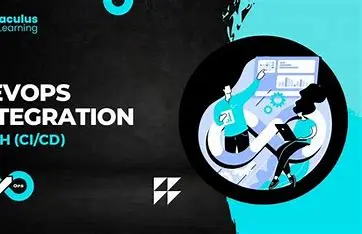CI/CD in DevOps: Streamlining Software Delivery for Speed and Reliability

In today’s fast-paced digital economy, software development is no longer a periodic event—it’s a continuous process. Users expect updates, new features, and fixes at a rapid pace, which traditional development methods often struggle to meet. This is where CI/CD (Continuous Integration and Continuous Deployment) steps in as a key pillar of modern DevOps practices.
CI/CD pipelines automate and streamline the process of building, testing, and deploying software, enabling teams to release high-quality applications faster and more reliably than ever before.
What is CI/CD?
CI/CD is a set of software engineering practices that automate the process of integrating code changes (CI) and delivering those changes to production (CD). It’s designed to eliminate manual errors, speed up development, and provide fast feedback loops for developers.
1. Continuous Integration (CI)
CI is the practice of frequently integrating code into a shared repository, where it’s automatically tested. Every time a developer pushes code, automated tests validate the changes to catch bugs early.
2. Continuous Deployment (CD)
CD picks up where CI ends. After the code passes all tests, it’s automatically deployed to staging or production environments, with no manual intervention. Some teams use Continuous Delivery, which is similar but may require a manual approval step before deployment.
Why CI/CD is Essential for DevOps
CI/CD is not just a convenience—it’s a necessity in modern DevOps culture. Here's why:
🔹 Speed and Agility
Developers can release new features, bug fixes, or enhancements multiple times a day, instead of once every few weeks or months.
🔹 Reliability and Consistency
Automated tests and deployment processes reduce the risk of human error and ensure consistent outcomes every time code is released.
🔹 Fast Feedback Loops
CI/CD provides developers immediate insights into whether their code changes break anything, enabling quicker fixes and better collaboration.
🔹 Easier Rollbacks and Recovery
CI/CD pipelines allow easy rollbacks to previous versions, minimizing downtime and enabling smoother incident response.
Popular CI/CD Tools in 2025
Tool Description Jenkins Open-source automation server, highly extensible GitHub Actions Native CI/CD for GitHub projects GitLab CI/CD Integrated CI/CD pipeline with Git repository CircleCI Cloud-native CI/CD platform with performance focus ArgoCD GitOps-based continuous delivery for Kubernetes Azure DevOps End-to-end DevOps services from Microsoft
How a CI/CD Pipeline Works
Code Commit
Developers push code changes to the version control system (e.g., Git).
Build
Code is compiled, dependencies installed, and artifacts generated.
Automated Testing
Unit tests, integration tests, and static code analysis are run.
Deployment
If tests pass, the code is automatically deployed to staging or production.
Monitoring
Tools like Prometheus, Grafana, or New Relic monitor the app's health post-deployment.
CI/CD in Action: Real-Life Scenarios
E-commerce platforms: Push out pricing changes, promotions, or new features during peak traffic without service interruptions.
Mobile apps: Release updates weekly or even daily without going through lengthy manual review processes.
SaaS products: Deploy microservices independently and safely with confidence.
Best Practices for CI/CD
Write testable code: A strong test suite is the backbone of CI.
Keep builds fast: Optimize your pipeline to give quick feedback.
Use feature flags: Control feature rollouts without redeploying code.
Secure secrets: Store API keys and credentials in vaults, not code.
Monitor deployments: Always observe post-deployment performance and stability.
Challenges and How to Overcome Them
Challenge Solution Flaky tests Regularly audit test reliability Long pipeline runtimes Use caching, parallel jobs, and smaller builds Poor test coverage Enforce code coverage thresholds Complex rollback strategy Use canary deployments or blue/green strategies Environment drift Use Infrastructure as Code (IaC) for parity
CI/CD and the Future of DevOps
CI/CD is evolving rapidly:
GitOps Integration: Tools like ArgoCD allow Git-driven, declarative deployment strategies.
Kubernetes-native CI/CD: Pipelines are increasingly built with cloud-native tools.
Event-driven workflows: Trigger pipelines based on specific events (e.g., commits, merges, alerts).
Platform engineering: Teams are building internal platforms to standardize CI/CD pipelines across projects.
With these trends, CI/CD continues to be the bridge between development velocity and operational excellence.
Conclusion
In an era where software drives everything from e-commerce to real estate, CI/CD empowers teams to deliver fast, reliable, and secure applications. By automating code integration and deployment, organizations can focus more on innovation and less on firefighting.
Whether you're just beginning your DevOps journey or scaling up your engineering team, embracing CI/CD is one of the smartest steps you can take toward operational maturity.
About Hexadecimal Software
Hexadecimal Software is a leading expert in software development and DevOps solutions. Our team helps businesses implement efficient CI/CD pipelines, automate infrastructure, and scale digital systems with confidence. Partner with Hexadecimal to bring speed, stability, and innovation to your tech stack.
Explore More on the HexaHome Blog
Discover more about the intersection of real estate, software development, and digital transformation at the HexaHome Blog — your hub for expert perspectives and industry trends.
